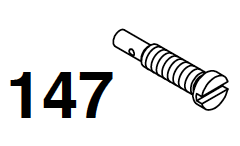Merkava_4 wrote:
Important Question:
Do you enlarge all three holes, or just the one hole on the end?
It depends on which mixture you wanna control or change.
Helps to understand how it works - much like a miniature carburetor within a carburetor air flow generally passes through the side holes (from the air bleed ports in front of carburetor - usually they themselves have a specific orifice size) and fuel will be coming in through the tip orifice - again note I say *usually* because exact function of the pilot jet may sometimes depend on which carburetor they are fitted to. But as a general rule they feed air and fuel through the idle passages to supply controlled idle mixture ratio to the idle ports in the carb for all idle ranges - change one hole and you change the whole fuel mixture balance (and often the actual "low speed adjustment screw" is only going to control , to a very limited extent, the *amount* of already mixed air-fuel mixture getting to the intake air stream) So.. as a general rule if the machine ran right to begin with, then something has altered that balance, and it is usually found within the carburetor.. and changing the orifice size (one or the other) may not necessarily achieve any results at all - if, for example, a blockage in the fuel feed side of things is simply preventing enough fuel through the fuel metering orifice of the pilot jet, enlarging the hole of the jet to "richen" the mixture ain't gonna do anything since the restriction is happening before the pilot jet .. Likewise - in some carburetors, the little brass air metering orifice for the air bleed might have been removed, or fallen out, etc by someone who does not know any better, causing excess air to reach the pilot jet - and again, changing orifice holes in the pilot jet itself may not necessarily resolve the issue..
So, a good understanding of just how the carburetor circuitry works can help a lot in making the decision to enlarge (or not) any of the fixed jet sizes.. I have yet to actually see a pilot jet that on close inspection was clear, that changing it would resolve a lean fuel mixture issue.. almost always finding the problem to be elsewhere in the carburetor, if not an air leak in the intake/exhaust.. on some engines and carburetors, simply putting a gasket on wrong (or an aftermarket gasket that isn't quite right) can be enough to disrupt the air flow pattern as it gets to the air bleeds resulting in an imbalance... or even just a tiny piece of dirt that makes its way past air filter, through the air bleed , through the pilot jet and partially blocking the idle circuit... or a flake of gum or varnish in the carb working loose (Possibly even as a *RESULT* of ultrasonic cleanign) restricting fuel flow before the pilot jet - either case, changing the pilot jet orifices would do very little to nothing at all..
How poor are they who have not patience. What wound did ever heal, but by degrees? - Iago (Othello Act II, Scene 3)



